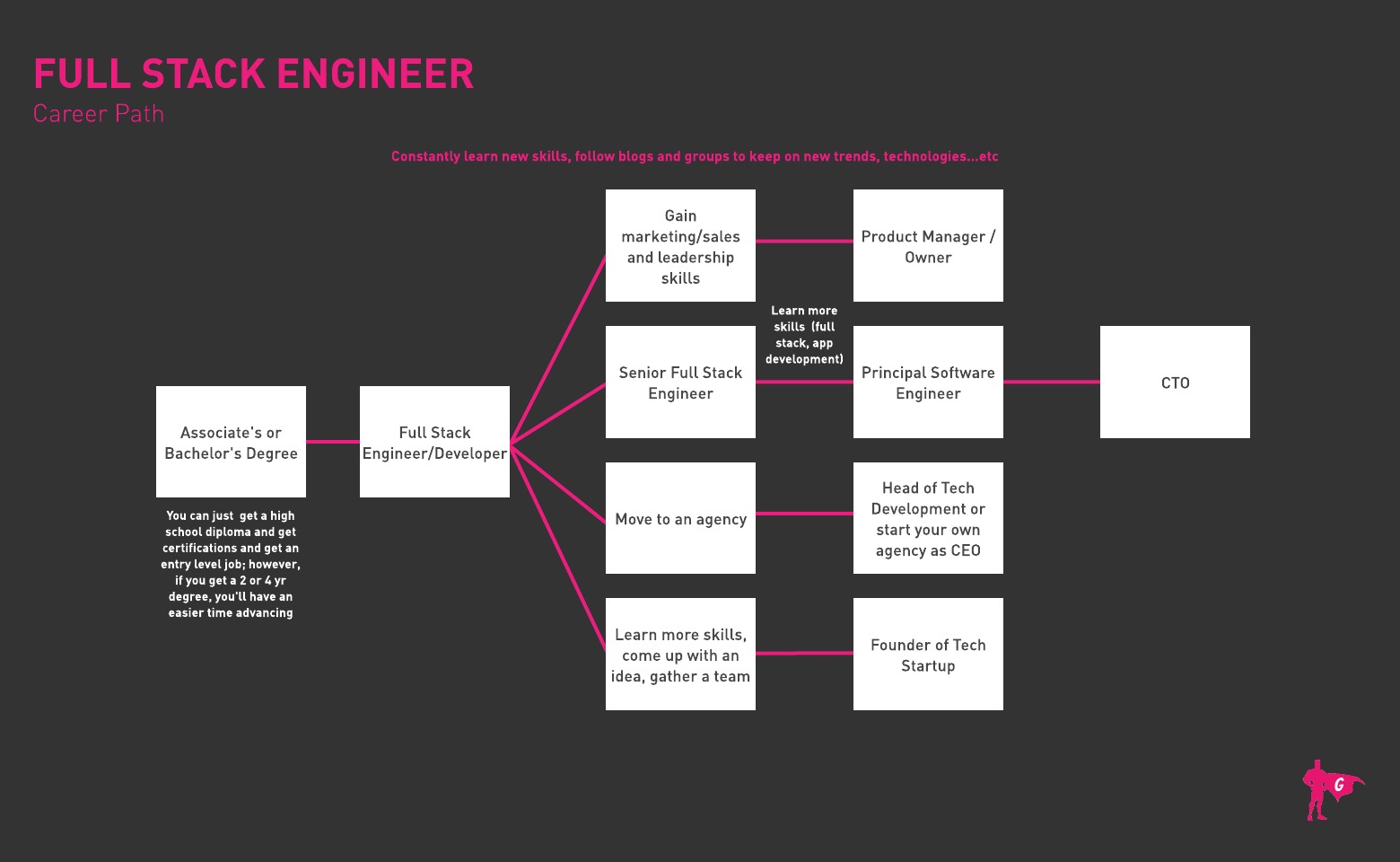Spotlights
Full Stack Developer, Full Stack Software Engineer, Full Stack Web Developer, Full Stack Architect, Full Stack Programmer, Full Stack Specialist, Full Stack Consultant, Full Stack Solutions Engineer, Full Stack Development Engineer, Full Stack Application Developer
A lot of work goes into crafting a custom website, which is why some developers choose to specialize in only one area. Front-End Developers, for instance, focus on the areas users can see and engage with, while Back-End Developers worry about the behind-the-scenes technicalities. Full Stack Developers, however, take on the whole enchilada (note, Full Stack Engineers are essentially senior-level Full Stack Developers, FYI).
Some clients don’t want the hassle of trying to figure out who does what. They just want someone who can do everything. Depending on the project, there can be overlap between front-end and back-end duties anyhow. That said, not all Full Stack Engineers are responsible for building entire websites from scratch. They might still work with teams as the project moves from the idea stage to development and launch.
Having a solid grasp of how both ends operate gives Full Stack Engineers a major edge. If help is needed, they’re able to dive in no matter where the problem lies. Full Stack basically amounts to being a hybrid of two (or more) career fields combined into one! They are masters of all areas, from front-end languages like HTML, CSS, and JavaScript, to some back-end languages like PHP, Ruby, or Python. Other talents can include design, User Experience, and project management.
- Comprehensive involvement in developing client sites
- Working with a wide range of programming languages and tools
- Exploring unlimited possibilities related to website creation
- Building powerful, cutting-edge sites to help companies dominate their spaces
- Amassing skills which can be used remotely, anywhere in the world
Working Schedule
- Full Stack Engineers have full plates when it comes to workloads. As a relatively rare (some say “mythical”) breed in the IT world, these workers can expect regular full-time hours. The supply of highly-qualified talent doesn’t currently meet the demand, so overtime may be necessary for some positions. Many developers work remotely from home or on a contractual basis. There’s also an ever-growing world of freelancers entering the field, many of which may operate abroad and thus offer highly competitive rates.
Typical Duties
- As an engineer, expect to serve in a project management capacity
- Meeting clients, User Experience and User Interface designers, and other developers to discuss requested functionalities, website design, and content ideas
- Planning the technical construction work needed
- Setting up processes for adding new pages
- Writing applicable code using a variety of languages
- Developing front-end architecture and back-end apps
- Building databases and services
- Testing for errors and responsiveness
- Ensuring mobile-friendliness
- Working with Application Programming Interfaces (APIs)
- Crafting graphics based on inputs from other team members and clients
- Making upgrades to existing sites to add new design features or functions
- Additional Responsibilities
- Conducting extensive testing to ensure code operates as desired
- Backing up files in case of problems
- Keeping up with industry-related changes and trends
Soft Skills
- Ability to learn from constructive feedback
- Attention to detail
- Awareness of user psychology
- Creative and artistic
- Customer service skills
- Decisiveness
- Highly organized
- Leadership and management skills
- Patient and analytical
- Proper phone and email etiquette
- Strong communications skills
- Team-oriented and goal-focused
- Time management skills
Technical Skills
- Front-end basics
- Server-side languages
- Knowledge of database technology
- Automation tools
- Command line
- CSS Preprocessors
- JavaScript frameworks
- jQuery
- Responsive design
- Testing and debugging programs
- Version control software
- Academic institutions
- Computer systems design agencies
- Corporations
- Governmental agencies
- Healthcare industries
- Large companies and organizations
- Management consulting firms
- Media and entertainment
- Military
- Publishing
- Self-employed
Who doesn’t have a website by this point? From government agencies and private corporations to film studios and musical artists, websites are how we share information and sell products and services in the modern world. A website is often the first (and in some cases, the only) contact a user or consumer has of an organization. Their experience may dictate whether or not they stay on the site and engage (or purchase something), or instead decide to leave and look elsewhere.
To a large extent, that decision relies on how well the Full Stack Engineer did their job. Websites that are unappealing, not compelling, difficult to navigate, or filled with glitches can tank interest before a user gets a chance to buy whatever is being sold. A poorly-built website also leaves organizations (and their user data) at risk of security breaches. Such compromises can destroy a brand’s reputation by stripping away user confidence (especially when millions of people have their data stolen at once).
The pressure is on Full Stack Engineers to create engaging, responsive sites that drive sales or user interaction while protecting the organization and users at the same time. When things go wrong or not as planned, managers look at who built their websites. As they say, if you can’t take the heat, stay out of the kitchen!
As physical stores and agencies continue to face slumping traffic, businesses have adapted by moving increasingly online and more to mobile apps. Everyone knows how Amazon, Apple, and Netflix revolutionized how we shop, consume media, and socialize. But these days, virtually all companies are getting in on the action.
From start-ups and small businesses to digital entrepreneurs, everybody wants a website, but not everyone has the same budget. Do-it-yourself sites like Wix, Squarespace, Site123, GoDaddy, and WordPress make it simpler than ever to build fast, cheap sites. Meanwhile, for customers who don’t have the basic skill, don’t want to learn them, or simply need something more customized, Full Stack Engineers remain the go-to hot commodity.
However, not everybody can afford to onboard a full-time engineer, which is why many work via short contracts, often doing the job remotely. The downside is that some organizations wanting to keep down costs will turn to overseas and/or freelance talent. This means Full Stack Engineers need to keep their skills sharp and find ways to distinguish their services from the competition.
As you can guess, Full Stack Engineers were likely always interested in computers and technology, and may have enjoyed spending time indoors. While social skills are an important part of the career field, workers were probably comfortable being on their own for long hours when they were younger. They’re creative, inquisitive, and eager to discover new things, especially in areas that most people know nothing about. Literally, they’re learning new languages, but ones used by computers instead of people.
To be a successful Full Stack Engineer, it’s good to have a keen interest in art and design. These passions are usually developed when growing up, either at home or in school. It might sound like this job requires “loner”-type personalities, but in fact, there is a considerable amount of teamwork and collaboration involved. Full Stack Engineers were likely happy to join groups and participate in social activities, or even to organize them. They are good at “seeing the big picture,” establishing goals, and managing tasks to ensure that end objectives are met.
- Full Stack Engineers typically need a bachelor’s in Computer Science or a related field
- Programming skills and practical work experience are critical
- Front-end basics — HTML, CSS, JavaScript languages
- Server-side languages — Python, Ruby, Java, PHP, .Net
- Database technology — MySQL, Oracle, MongoDB
- Automation tools (Grunt, gulp)
- Command line
- Flash
- CSS Preprocessors — Sass, Less, Stylus
- JavaScript frameworks — Ember, React, Bootstrap, AngularJS
- jQuery
- Responsive design
- Testing and debugging programs
- Version control software (Git)
- Experience with Agile methodology
- Courses to build soft skills such as English fluency, clear writing and speaking, teamwork, and leadership
- Learn on your own with the following:
- LinkedIn Learning’s Full Stack course offerings
- Udacity’s Full Stack Web Developer
- CompTIA’s IT Fundamentals
- Udemy:
- The Complete 2020 Web Development Bootcamp
- Coursera:
- Full Stack Web and Multiplatform Mobile App Development Specialization
- Full-Stack Web Development with React Specialization
- Web Design for Everybody: Basics of Web Development & Coding Specialization
- Responsive Website Development and Design Specialization
- edX Full Stack Web Developer Courses (edX)
- Pluralsight
- Vendor/tech-specific certifications such as Google Cloud, RedHat, Microsoft (MTA, MSCA, MSCE)
- Not every college degree can give you the practical skills needed for this career field, so consider which programs offer the same experiences as a Bootcamp
- Closely review the programs’ stats on job placements after graduation
- Look into all career services, to ensure they can help you with resume writing, mock interviews, or other areas
- Read faculty bios; review the program’s facilities, areas of research, and funding
- Ensure the institution is fully accredited
- Consider the pros and cons of taking online or hybrid classes
- Remember, there’s a difference between being a Full Stack Developer and Full Stack Engineer. A survey by Stack Overflow found that 25% of professional developers don’t have a bachelor's. Of those who do, one-third didn’t have one in CS of software engineering. An engineer position is more likely to require a degree
- Practice and practice more! Most of the basics you’ll need can be learned in your own free time (see our Education and Training recommendations above)
- Did we already say practice? Keep doing it, but don’t stay too focused on any one area; a Full Stack Engineer needs to master many skills
- Note, there’s some debate about the concept of Full Stack Developers and how well one individual can truly become proficient with so many skills. One of the keys is to start early, be organized, and use your time efficiently!
- Maintain a portfolio of projects you completed, with detailed notes of what you did and what the obstacles and solutions were
- Help your school and friends with their websites, and get some free, real-world practice
- Hunt for internships offering practical (and paid!) work experience
- Carve out some freelance credentials on Upwork and start earning feedbacks
- Join computer clubs; network with peers and seek experienced coders to mentor you
- Study the art of communication! Learn to speak, listen, and write professionally, compellingly, and with confidence
- Don’t rest on your laurels. Keep your skills sharp with lots of reading and hands-on work
- Train others, in-person or online, by writing informative blogs or creating YouTube videos. Practice explaining things to others and receive feedback from the audience
- Read articles and participate in discussions on Quora, Reddit, Dev.to, and other spaces

- Take the TripleByte Quiz and they will connect you with employers if you pass the screening test
- Look for openings via Indeed, Monster, USAJobs, ZipRecruiter, LinkedIn, Velvet Jobs, and Glassdoor
- Tell your network you’re job-seeking. Ask them to contact you with any good leads
- Ask your school’s department or career center for info about job fairs, recruiting events, internships, and other assistance such as resume writing and interviewing practice
- Pay close attention to the required experience and skills listed in job postings
- Competition is fierce, so focus your energies on jobs you’re highly qualified for, and tailor your resume to each specific job you apply to
- Think like a recruiter! Read HackerEarth’s “How to hire a full stack developer”
- Include a link to your Full Stack portfolio, which should list your tech skills, personal projects, and projects on GitHub, CodePen, or other sites
- Give context — explain the Who, What, Where, When, Why, and How
- Don’t reinvent the resume wheel; there are loads of great customizable templates online
- Make an amazing first impression at interviews and show off your soft skills
- If you work for an organization, make it clear that you’re interested in higher-level positions, and want to learn the internal processes for achieving those goals
- It might make sense to pursue a Master’s in Web Development; talk with your supervisor or manager to find out their requirements for promotion
- At the Full Stack Engineer-level, you’ll need to understand what types of senior positions are available for you. Some companies may not have any promotion opportunities
- To advance, it may be necessary to consider positions with other employers
- If you’re self-employed, the only limits are self-imposed! Set your bar as high as you want, and pursue the education and training you need to get there
- In this field, it is imperative to keep abreast of new developments. Changes don’t occur overnight, but they can sneak up on you
- Always meet deadlines and do amazing work for your clients
- Promote yourself as an expert in the field. Make your own website, YouTube channel, and social media accounts to get attention for your personal brand
- Teach classes. If you’ve got the time and credentials, look for part-time work as an instructor. Being affiliated with a university always looks great on a resume
- Get published in industry print mags like Net, How, Layers, Computer Arts, Digital Arts, Web Designer, CMYK, and others
Websites
- Association for Computing Machinery
- Brilliant
- Bureau of Labor Statistics’ Occupational Outlook Handbook
- CodeSignal
- Codewars
- CodinGame
- CompTIA
- CompTIA Association of IT Professionals
- Coursera
- edX
- Exercism
- freeCodeCamp
- Frontendmasters
- HackerEarth
- HackerRank
- Javascript30
- Rithm School
- Udemy
- W3Schools: Javascript
- World Organization of Webmasters
Books
- Full-Stack React Projects: Learn MERN stack development by building modern web apps using MongoDB, Express, React, and Node.js, 2nd Edition, by Shama Hoque
- The Full Stack Developer, by Chris Northwood
- Hands-On Full-Stack Web Development with GraphQL and React, by Sebastian Grebe
- Modern Full-Stack Development, by Frank Zammetti
- Web Design with HTML, CSS, JavaScript and jQuery Set, by Jon Duckett
- Web Coding & Development All-in-One For Dummies, by Paul McFedries
Becoming a Full Stack Engineer is not an easy matter. As we mentioned, it’s basically two jobs combined into one. Many people prefer to focus on either front-end or back-end development. Meanwhile, some workers decide to get away from web development altogether. The Bureau of Labor Statistics offers many alternative career paths, such as:
- Computer and Information Systems Managers
- Computer Programmers
- Computer Support Specialists
- Computer Systems Analysts
- Database Administrators
- Graphic Designers
- Information Security Analysts
- Multimedia Artists and Animators
- Software Developers
Newsfeed

Featured Jobs

Online Courses and Tools








